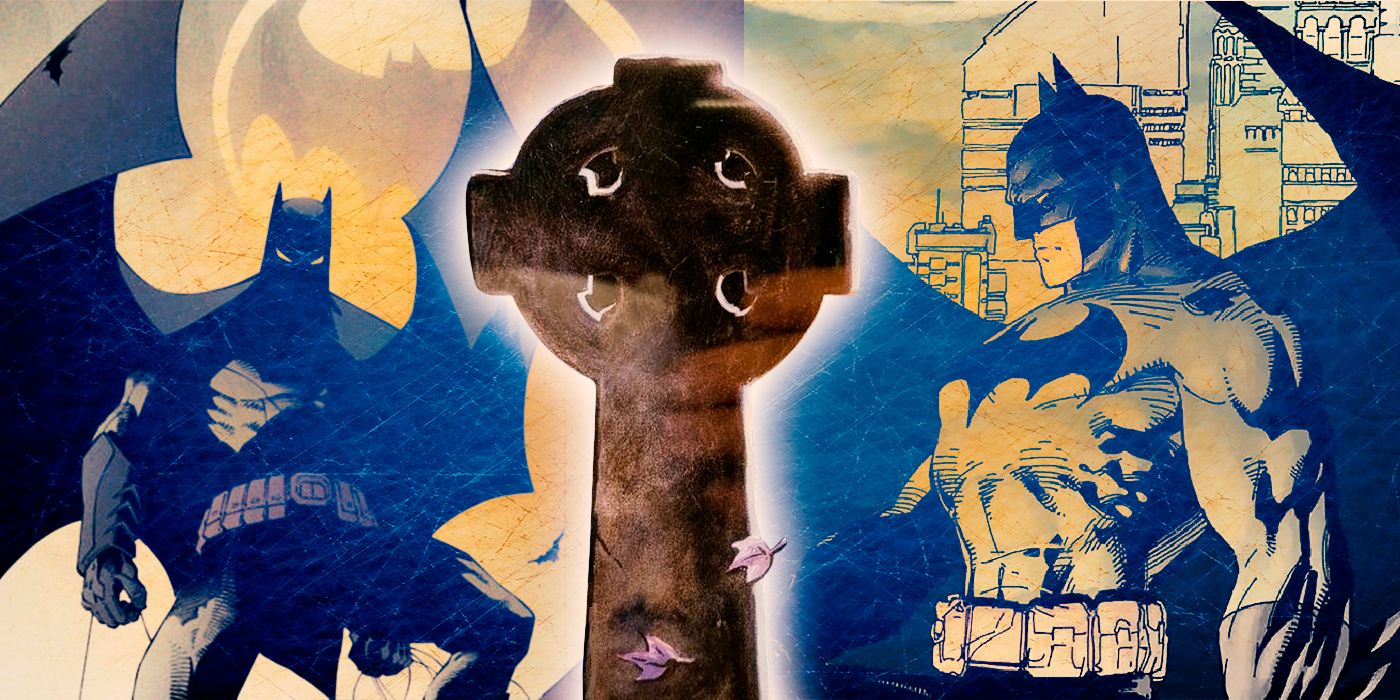Since the Silver Age, DC Comics has slowly managed to transform Batman into their biggest hero, placing him front and center in some of their biggest events and bestselling comics. Throughout the hero’s almost ninety-year existence, some of his best stories have actually ended in his death. As strange as his returns to life may be, a classic story from DC’s Silver Age may answer the question of how the hero keeps coming back from the underworld.
Batman lives in Gotham, possibly the most dangerous city in comics, surrounded on all fronts by gangs, supervillains, killer clowns, and mafia families. His war on crime has placed a target on his back since the hero’s origins, and some of his earliest cases landed him face-to-face with the city’s most dangerous gangsters. Throughout his development at DC, he has cultivated one of the deadliest rogues galleries in DC history, from Joker and Bane to Two-Face and the Maroni and Falcone crime families. However, his closest brush with death came at his own hands when he infiltrated the elusive and mysterious Death Cheaters club, where the hero’s apparent ability to cheat death could have its origins.
RELATED: 10 Main Reasons DC Will Never Completely Reboot Batman
Batman’s Many Deaths In DC Comics
Since the Golden Age of Comics, Batman has always faced many close brushes with death, not to mention the times he seemed to die. Throughout the multiverse and DC history, Batman has been killed many times over, sometimes being resurrected, other times miraculously returning unscathed. For example, in the alternate universe of Superman/Batman, the two titular heroes became tyrants, and Wonder Woman delivered deadly justice to Batman. In his battle with Joker in the New 52’s Endgame, both characters seemed to die in their battle, only for both hero and villain to promptly return from the dead. Perhaps the Dark Knight’s most famous death was at the hands of Darkseid in Final Crisis (Grant Morrison & JG Jones), though that turned out to be a complicated time travel narrative.
While some of Batman’s deaths and rebirths can be explained away through timeline shenanigans and company reboots, this doesn’t account for everything. Batman’s skill at deceiving death also played an important role in Frank Miller’s The Dark Knight Returns. Here, Batman managed to convince even Superman that his heart gave out after he defeated Superman in hand-to-hand combat. Likewise, in The Last Knight On Earth (Scott Snyder & Greg Capullo), that version of Bruce Wayne had been violently murdered, but he resurfaced alive, though badly scarred by the violence. Given how many of these alternate universes share a past with the regular DCU, he might well have joined the Death Cheaters in those worlds too.
RELATED: 10 Things Batman Does Better Than Superman (& Always Will)
Batman’s Encounter With The Death Cheaters Of Gotham
A story in Batman #72, “The Death Cheaters of Gotham City” (David Vern & Jim Mooney), introduced readers to an elite club of men who had miraculously cheated death. It was strongly hinted that these men had developed an addiction to both narrow brushes with death and the very act of dying and being revived. However, shortly after rejecting a newcomer for having a criminal record (of all things,) members of the club started getting murdered in the manner they had originally “died.” As Batman raced to save as many Death Cheaters as he could, he eventually concluded that the best course of action was for Bruce Wayne to join. The only problem with his plan was that, if he wanted to become a Death Cheater, Bruce had to die.
Before swallowing a bottle of poison that would temporarily “kill” him, Bruce Wayne arranged for Alfred, Robin, and a doctor to bear witness to his death, so the news would reach the Death Cheaters. Fortunately, the club got word of Bruce’s brush with death and welcomed him into the fold. The natural suspect in the murders was the man recently rejected by the club, Dougy. However, after an encounter with the reject convinced Batman otherwise, he realized Dougy was being framed. It was actually the club’s accountant, Sievers, who had embezzled money and planned to live out a new life after faking his own death.
While it may be easy to look at the deaths of these men and pass them off as fluke survivals, the actual nature of their deaths were quite extreme. Though some of them were saved by medical interventions, others miraculously came back to life unaided, spending up to twenty-three minutes dead. Such things are unheard of in the real world, but in the supernatural, mythical world of DC, it’s entirely possible. When factoring in Batman’s numerous brushes with death, his spiritual training in Nanda Parbat, and his mastery over his own physiology, it’s more than believable that his brush with the Death-Cheaters left him with a unique ability. It could be that living on borrowed time has made Batman impervious to any form of death than the one that originally claimed his life: Poison.
RELATED: Why Long Comic Book Runs Need A Comeback
Other Possible Explanations For Batman’s Immortality
“The Death Cheaters of Gotham” does offer up its own plausible explanation for how Batman keeps returning from the dead. However, this one-off story isn’t the only explanation in DC comics. In a battle with Ra’s al Ghul when the villain sought to “purify” the planet, Batman sustained a mortal wound at the hands of the villain. In a desperate bid to stop the ancient monster’s plan, Batman dragged al Ghul into the Lazarus Pits with him, and both characters emerged with their life forces replenished. It’s actually possible that, combined with the hero’s brush with death, the Lazarus resin enhanced his abilities to survive fatal circumstances. The Bronze Age especially had a love of toying with the idea of a dead Batman, bringing him back as though nothing happened without warning.
Batman has had countless experiences with magic, death and resurrection. At this point, it wouldn’t surprise anyone to learn Batman actually has some form of magical protection from death, even if he didn’t create or commission it. After all, the Death Cheaters aside, some of the hero’s closest allies, like Zatanna and Constantine, have given the Dark Knight magical protection. Not to mention the supernatural possessions and mystical training that helped him hone abilities like astral projection. All of this combined paints a picture of a hero who’s a formidable foe even in death.
Batman has come into contact with so many strange artifacts and devices that he should have been changed dramatically by them. Lazarus Pits aside, the hero sat in the Mobius Chair of Metron, used Mother Boxes, was sent to Hell itself, and was possessed by everyone from Deadman to the demon Nezha. Suffice it to say, he stopped being a common mortal long ago. The Dark Knight has ascended to godhood, he’s bathed in rejuvenation pits and been blessed with mystical healing. He may not be on Superman’s level, but he’s hardly a normal man at this point. The “Emperor Joker” story showed a version of Joker with Fifth-Dimensional powers who kept killing and resurrecting Batman, perhaps also contributing to the hero’s undying nature. Between magic and cosmic gods, it’s hard to tell where Batman’s limits are.
RELATED: 10 Best DC Comic Events That Actually Changed The Status Quo
Batman’s Death Cheaters Explain A Lot
The fact that Batman has essentially come back from the dead so often isn’t the only thing about the Caped Crusader that the Death Cheaters could explain. Batman absorbs fatal wounds fairly casually, ranging from extreme blunt force trauma in Hush to stab wounds that would kill any normal man. Bruce Wayne has trained himself to be in peak human condition, but some of his injuries are just too extreme. Stories like Endgame are good examples of the Caped Crusader surviving events that should have left him dead. Just as Ra’s al Ghul has his Lazarus Pits, it’s conceivable that Batman accidentally made a kind of bargain with death when he helped the Death Cheaters. This makes him next to invincible to the typical tactics of his regular villains.
The Death Cheaters club and their activities could certainly have used some deeper exploration, rather than just focusing on the murder investigation angle. Readers didn’t get to see the full implications of this club or its members’ condition, but they apparently specialized in recreating narrow brushes with death. Considering how they emphasized the fact that they’re living on borrowed time and the “miraculous” nature of their revivals, there’s a strong case to make for a supernatural angle. Though it will never be canonical, Batman is, for all intents and purposes, immortal in DC Comics, whether that’s chalked up to plot armor or supernatural intervention.
In the Silver Age, Batman joined the Death-Cheaters club. While DC’s Dark Knight famously doesn’t have superpowers, is he secretly immortal? Read More

